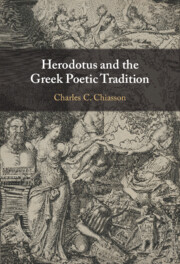Refine search
Actions for selected content:
260 results
Introduction
-
- Book:
- Herodotus and the Greek Poetic Tradition
- Published online:
- 04 November 2025
- Print publication:
- 06 November 2025, pp 1-10
-
- Chapter
- Export citation

Herodotus and the Greek Poetic Tradition
-
- Published online:
- 04 November 2025
- Print publication:
- 06 November 2025
Portrait of a Martyr as a Young Man: Social Lives of Photographs in Revolutionary Egypt
-
- Journal:
- Comparative Studies in Society and History , First View
- Published online by Cambridge University Press:
- 24 October 2025, pp. 1-34
-
- Article
-
- You have access
- Open access
- HTML
- Export citation
Introduction
-
-
- Book:
- Reckoning with Law in Excess
- Published online:
- 09 September 2025
- Print publication:
- 25 September 2025, pp 1-23
-
- Chapter
-
- You have access
- Open access
- HTML
- Export citation
6 - Seeing the Past
-
-
- Book:
- Relief in Greek, Roman, and Late Antique Art
- Published online:
- 11 October 2025
- Print publication:
- 25 September 2025, pp 199-231
-
- Chapter
- Export citation
Chapter 1 - The Irish Revival
- from Part I - Revivalism and the Call for Renewal
-
-
- Book:
- The Revival in Irish Literature and Culture
- Published online:
- 04 September 2025
- Print publication:
- 18 September 2025, pp 31-52
-
- Chapter
- Export citation
Chapter 9 - “A Living Testament to the Struggle for a Better Future”
- from Part II - The Politics of the Irish Revival
-
-
- Book:
- The Revival in Irish Literature and Culture
- Published online:
- 04 September 2025
- Print publication:
- 18 September 2025, pp 182-200
-
- Chapter
- Export citation
Chapter 17 - The Uncertainty of Coming Times in Contemporary Irish Fiction
- from Part IV - Revivalist Futures
-
-
- Book:
- The Revival in Irish Literature and Culture
- Published online:
- 04 September 2025
- Print publication:
- 18 September 2025, pp 341-359
-
- Chapter
- Export citation
Chapter 8 - The Healer and the Witch
- from Part II - The Politics of the Irish Revival
-
-
- Book:
- The Revival in Irish Literature and Culture
- Published online:
- 04 September 2025
- Print publication:
- 18 September 2025, pp 164-181
-
- Chapter
- Export citation
Chapter 12 - History and the British Novel After Postmodernism
-
-
- Book:
- The Cambridge Companion to British Postmodern Fiction
- Published online:
- 07 August 2025
- Print publication:
- 21 August 2025, pp 191-205
-
- Chapter
- Export citation
Hell is Other Poets: Tibullus, Ovid and Statius in Queer Elysium
-
- Journal:
- The Journal of Roman Studies , First View
- Published online by Cambridge University Press:
- 15 August 2025, pp. 1-34
-
- Article
-
- You have access
- Open access
- HTML
- Export citation
2 - The Promise of Non-Recurrence
-
- Book:
- Governing the Past
- Published online:
- 30 July 2025
- Print publication:
- 07 August 2025, pp 35-64
-
- Chapter
- Export citation
Rupturing the Temporality of Pharmaceutical Patents: A Sketch for a New Temporal Economy of Pharmaceutical Markets
-
- Journal:
- Journal of Law, Medicine & Ethics / Volume 53 / Issue 3 / Fall 2025
- Published online by Cambridge University Press:
- 18 July 2025, pp. 337-344
- Print publication:
- Fall 2025
-
- Article
-
- You have access
- Open access
- HTML
- Export citation
The Future of (Environmental) History: A Roundtable Discussion
- Part of
-
- Journal:
- Transactions of the Royal Historical Society / Volume 3 / December 2025
- Published online by Cambridge University Press:
- 17 July 2025, pp. 427-447
- Print publication:
- December 2025
-
- Article
-
- You have access
- Open access
- HTML
- Export citation
Chapter 4 - Beyond
-
- Book:
- Embodiment in Nineteenth-Century American Literature
- Published online:
- 29 June 2025
- Print publication:
- 17 July 2025, pp 126-149
-
- Chapter
- Export citation
7 - The Inflexible Self and Lived Time
- from Part II - Contemporary Approaches to Traditional Conceptual Perspectives
-
-
- Book:
- Conceptualizing Personality Disorder
- Published online:
- 25 June 2025
- Print publication:
- 10 July 2025, pp 130-146
-
- Chapter
- Export citation
Chapter 5 - On Curiosity as Epistemic Vice
-
-
- Book:
- Heidegger's <i>Being and Time</i>
- Published online:
- 28 June 2025
- Print publication:
- 26 June 2025, pp 84-102
-
- Chapter
- Export citation
Chapter 12 - Heidegger on the Failure of Being and Time
-
-
- Book:
- Heidegger's <i>Being and Time</i>
- Published online:
- 28 June 2025
- Print publication:
- 26 June 2025, pp 248-273
-
- Chapter
- Export citation
Chapter 17 - Capitalist Realism
- from Part III - Forms of Realism
-
-
- Book:
- Realism and the Novel
- Published online:
- 05 June 2025
- Print publication:
- 19 June 2025, pp 242-256
-
- Chapter
- Export citation
Against temporal abstractions: the battle for colonial and climate reparations in international law
-
- Journal:
- International Journal of Law in Context / Volume 21 / Issue 2 / June 2025
- Published online by Cambridge University Press:
- 30 May 2025, pp. 281-299
-
- Article
-
- You have access
- Open access
- HTML
- Export citation
